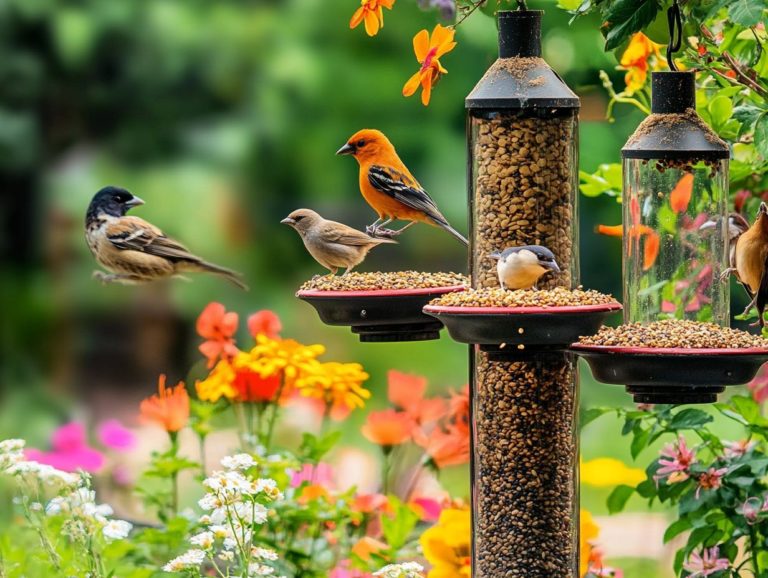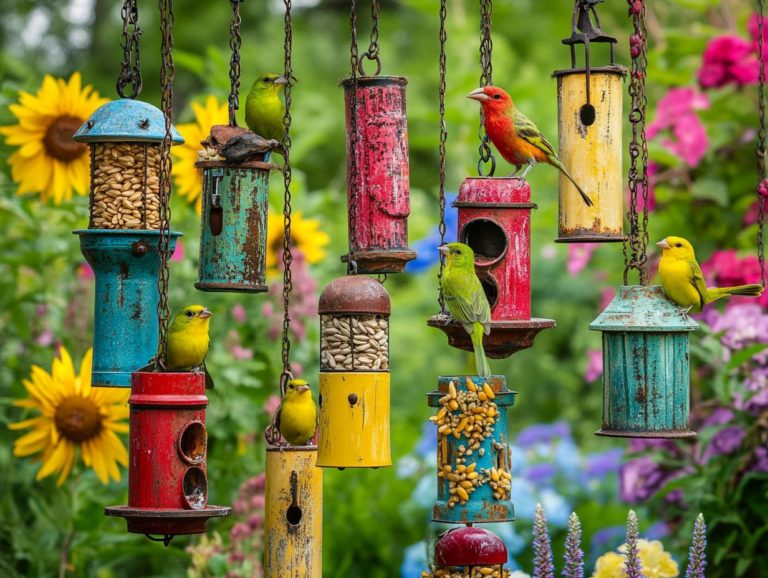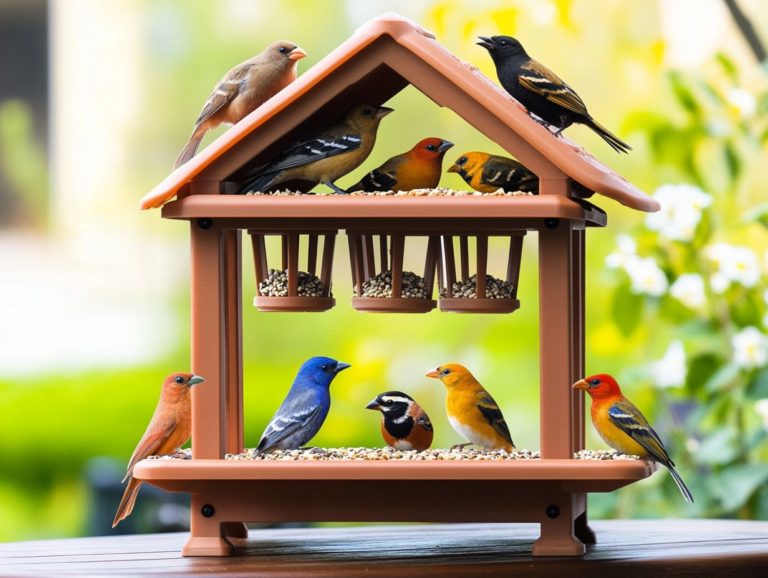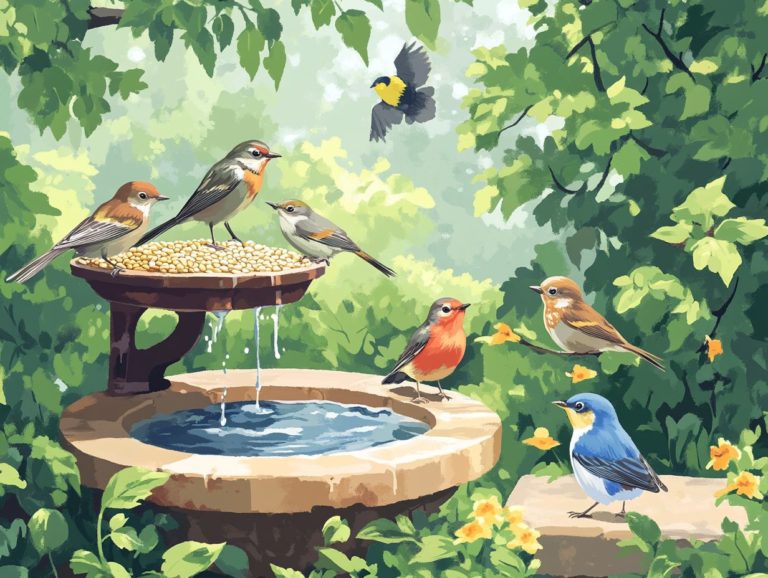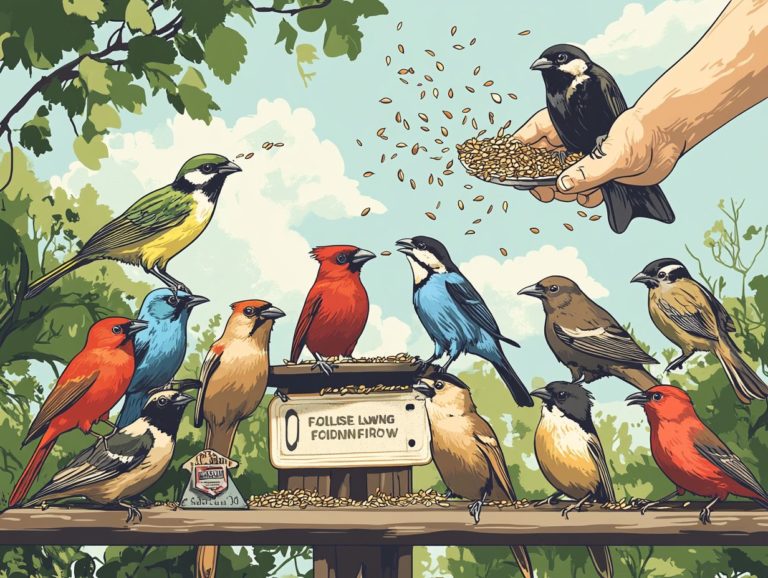Feeding Birds: What You Need to Know
Feeding birds can effortlessly transform your backyard into a vibrant sanctuary, drawing in a delightful array of feathered companions.
This guide will explore the many reasons to feed birds, the various species you can attract, and how to choose the ideal feed for your avian visitors.
You will learn about effective feeding methods, common pitfalls to avoid, and the numerous benefits bird feeding brings, both for the environment and your own well-being.
Discover how simple actions can create a thriving, bird-friendly habitat right outside your window, enriching your outdoor experience.
Contents
Key Takeaways:
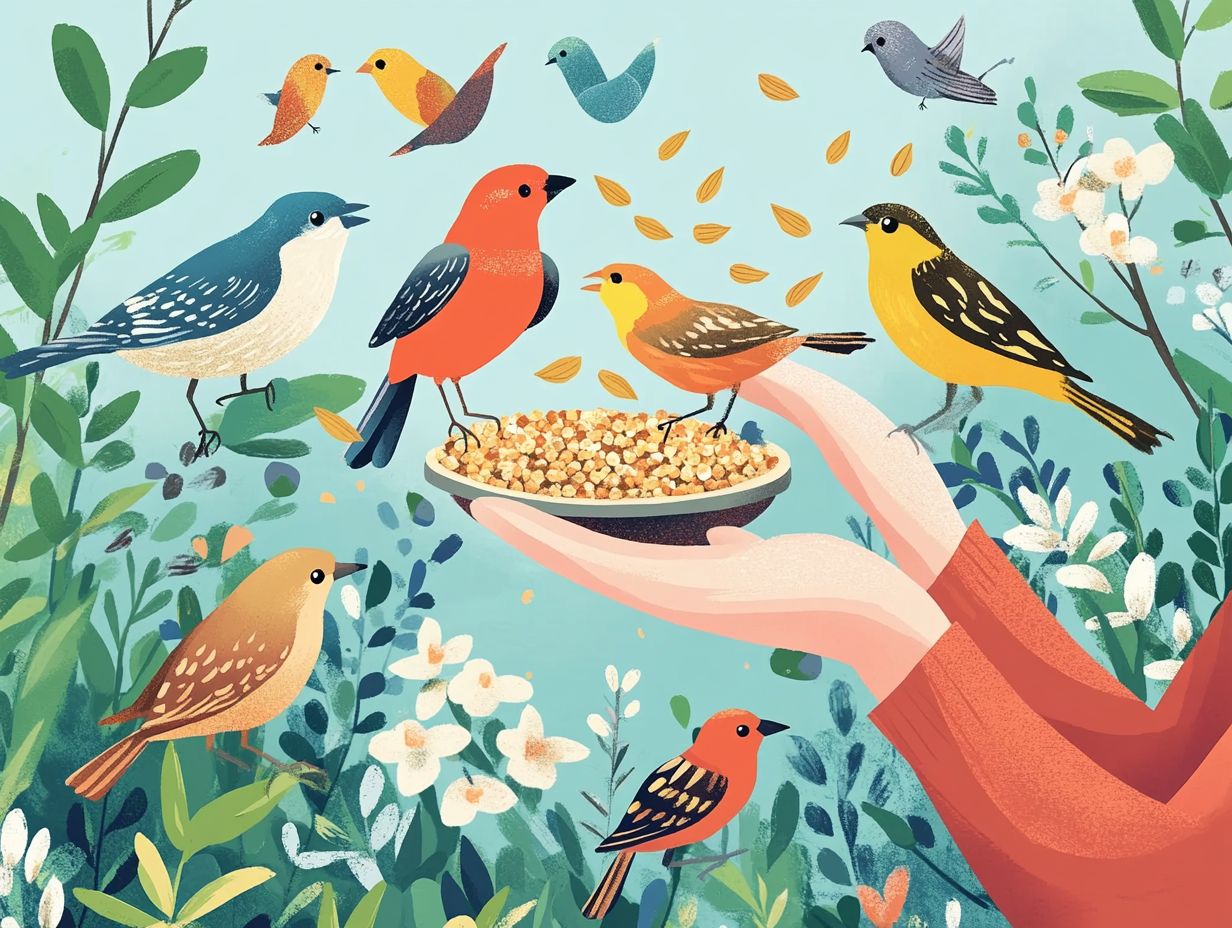
- Feeding birds has both environmental and personal benefits, including maintaining the natural ecosystem and bringing joy to your daily life.
- When choosing bird feed, consider the types of birds you want to attract, their dietary needs, and the quality and freshness of the feed.
- Proper feeder placement and maintenance are essential for attracting specific bird species and avoiding mistakes like overfeeding or attracting pests.
Why Feed Birds?
Feeding birds is more than just a hobby; it s a vital practice for anyone passionate about wildlife conservation and backyard birding.
By offering a variety of feeders filled with nutritious delights like sunflower seeds, mealworms, and suet during winter, you actively support avian populations and develop a deeper connection with nature.
However, it’s important to recognize the challenges of this rewarding endeavor, such as potential interactions with outdoor cats and the responsibility of maintaining clean, safe feeding areas.
This fulfilling activity attracts a diverse range of bird species, significantly enhancing the biodiversity of your local environment.
Observing the myriad behaviors of these feathered visitors like how they compete for food or interact with each other can deepen your appreciation for their intricate social structures.
Setting up a safe feeding zone protects our feathered friends from outdoor cats, which threaten bird populations.
By choosing to feed birds responsibly, you contribute to ecological balance while enriching your emotional well-being.
The simple act of birdwatching can bring solace and joy to your daily life, turning your backyard into a vibrant sanctuary.
Types of Birds to Feed
To create a successful bird feeding environment, understanding the types of birds you re likely to attract is crucial.
If you want to attract hummingbirds, sweet nectar will do the trick. In contrast, woodpeckers can t resist suet and peanuts, while ground-feeding birds like sparrows and orioles thrive on seeds and fruit served in secure metal containers.
Setting up various feeders significantly enhances your chances of attracting a diverse avian population.
Tube feeders are perfect for finches that enjoy nyjer seed (a favorite of finches), while platform feeders provide a communal dining experience for various species.
It’s equally important to consider the behavioral traits of the birds. Some, like cardinals, prefer open spaces for spotting potential threats, while others seek the safety of dense shrubs.
By mimicking their natural feeding environments and offering a range of food options, you can create a thriving habitat that encourages frequent visits from your feathered friends.
Choosing the Right Bird Feed
Choosing the right bird feed is essential for attracting a diverse array of birds to your backyard, starting with a solid grasp of the feeders available and the unique needs of birds in your area.
Whether it s sunflower seeds or specialized blends featuring mealworms and thistle seeds, the perfect mix can elevate your bird-watching experience.
Proper seed storage is essential for keeping everything fresh and enticing for your feathered visitors.
Types of Bird Feed
Knowing the various types of bird feed is crucial for attracting a vibrant array of species to your backyard sanctuary. Common choices include sunflower seeds, which are a favorite among many birds like cardinals and bluebirds. Suet is also a great option for winter feeding.
You might also consider specialized offerings like mealworms for those protein-loving birds, sweet nectar for hummingbirds, and delightful snacks like raisins and peanuts for unique visitors.
By selecting the right combinations, you can create a lively feeding station that caters to a wide range of avian preferences. For example, nyjer seeds are particularly enticing to finches, while a mixed seed blend can draw a variety of sparrows.
Offering peanut butter smeared on tree bark could attract woodpeckers and nuthatches seeking energy-rich options.
This thoughtful approach not only enhances your bird-watching experiences but also deepens your connection to the local ecosystem as you discover the specific dietary needs of different bird species.
Considerations for Different Bird Species
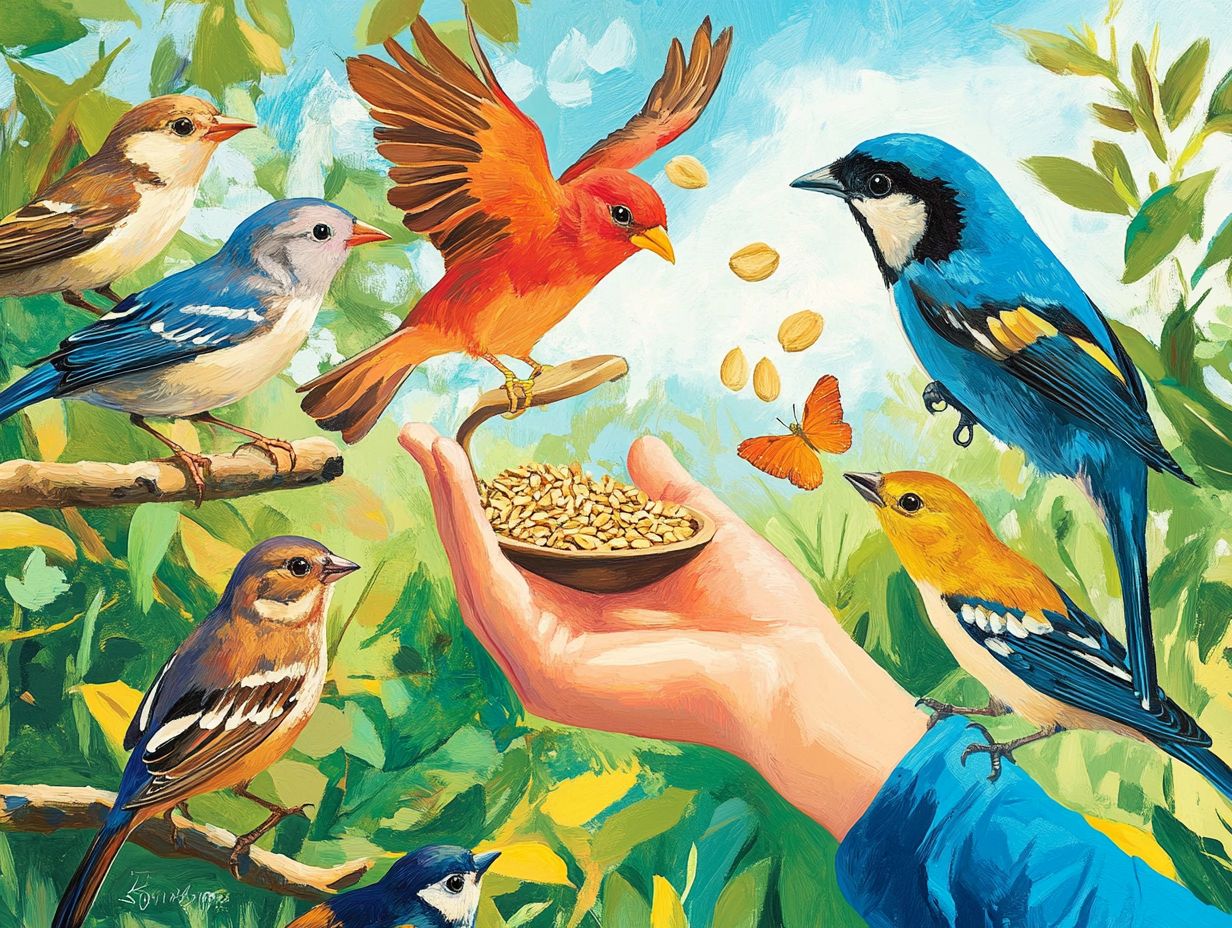
When you re feeding birds, it s essential to consider the unique needs and behaviors of various species to create the best way to feed birds. Some birds prefer feeders that allow them to cling, while others, like ground-feeding sparrows, thrive in more open feeding areas.
Knowing these behaviors helps attract many types of birds. Be mindful of the types of seeds and food you choose, as preferences can vary dramatically.
Finches might feast on nyjer seeds, while cardinals typically gravitate towards sunflower seeds. Selecting the right feeder type can truly make a difference tube feeders are fantastic for clinging birds, while platform or tray feeders are perfect for those foraging on the ground.
To elevate the bird feeding experience even further, consider adding a water feature. This not only provides hydration but also introduces an enchanting element that can draw in a wider variety of species, transforming your backyard into an extraordinary bird-watching haven!
Feeding Methods and Techniques
Effective bird feeding requires a blend of techniques and methods to ensure your efforts truly pay off while prioritizing the well-being of visiting birds. This involves strategically placing feeders, regularly cleaning them to prevent disease, and utilizing squirrel-proof feeders to keep unwanted visitors at bay.
By taking these steps, you create a safe feeding environment that also considers the important part of keeping birds safe.
Feeder Placement and Maintenance
Feeder placement and maintenance are pivotal elements that can greatly influence the success of your bird feeding endeavors. By strategically positioning your feeders attuned to bird behavior and their preferred habitats you can enhance visibility and accessibility for various species.
Routine cleaning of feeders creates a healthy feeding environment that consistently attracts birds.
To choose the ideal spot for your feeders, observe local bird activity and grasp their natural tendencies. For instance, placing feeders near trees or shrubs offers essential cover from predators, elevating their comfort levels.
It s also wise to position feeding stations away from high-traffic areas to minimize disturbances. Establishing a regular maintenance routine, including weekly cleaning and replenishing food supplies, is crucial to prevent mold growth and disease, fostering a flourishing bird community.
By prioritizing these elements, you can craft inviting spaces that encourage delightful interactions with a diverse array of avian visitors.
Attracting Specific Bird Species
Attracting specific bird species to your backyard is an exciting challenge that calls for a thoughtful strategy, especially regarding the feeders and specialty foods you choose. For instance, if you offer sunflower seeds in tube feeders, you might find yourself drawing in a delightful array of finches!
Suet or mealworms could be the secret ingredients to entice woodpeckers and nuthatches, showcasing the wonderful variety at your disposal. Consider using platform feeders filled with cracked corn to invite larger birds like doves and jays to your feeding station.
If you want to attract hummingbirds, you ll need a well-placed feeder filled with a sugar-water solution. The sight of these dazzling creatures flitting about will surely brighten your day!
Understand what each bird loves to eat! This knowledge is key. For example, sparrows often enjoy millet, while chickadees lean toward protein-packed seeds like peanuts. By diversifying your feeders and offerings, you can transform your backyard into a vibrant oasis!
Common Mistakes when Feeding Birds
Feeding birds can be a rewarding experience, but many enthusiasts fall into common traps that can undermine their efforts or even endanger the birds themselves. To avoid these pitfalls, consider the top bird feeding tips for beginners.
Overfeeding or underfeeding can result in unhealthy birds. Improper seed storage may attract unwelcome pests. You must understand these bird-feeding risks and learn how to sidestep them for a more fulfilling and responsible bird-watching journey.
Overfeeding or Underfeeding
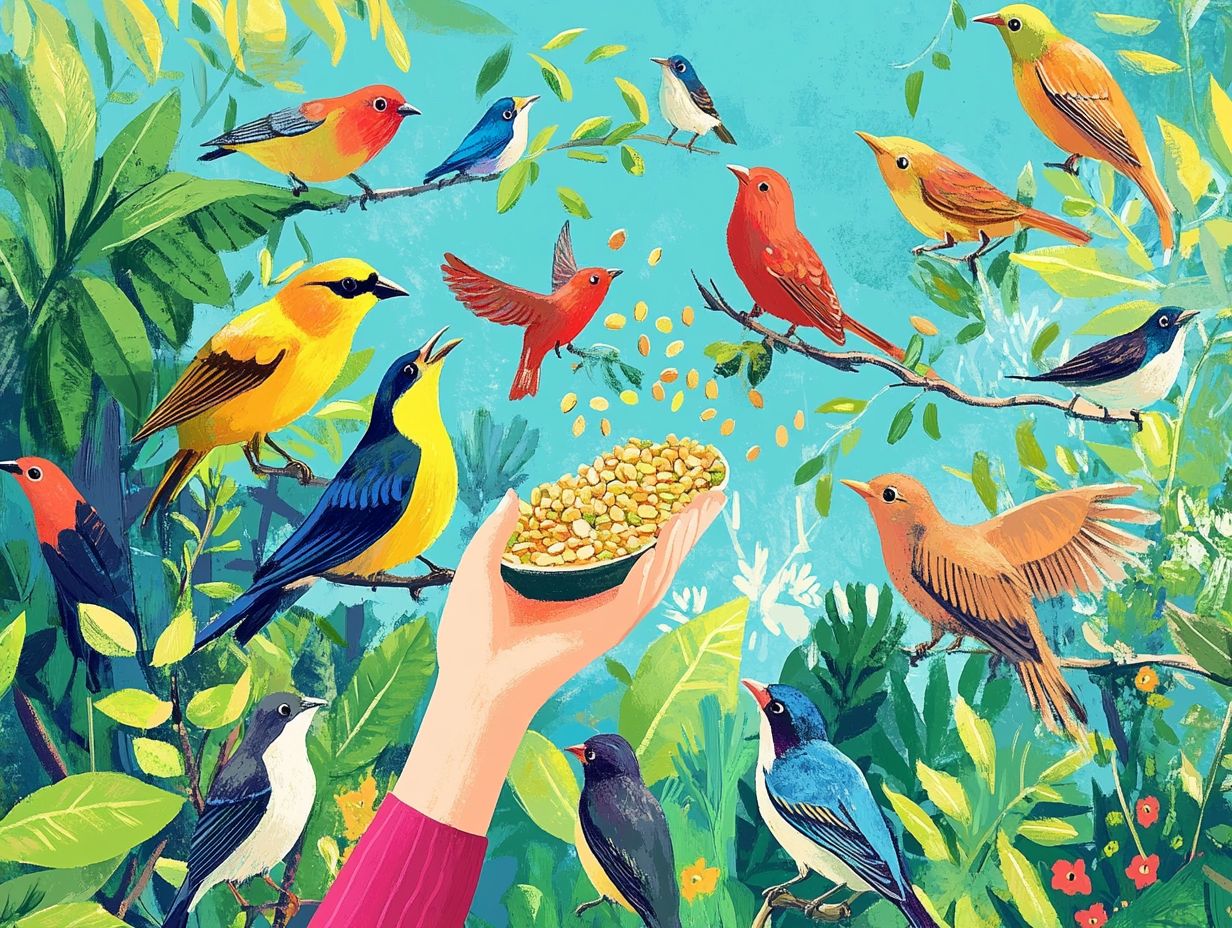
One of the most significant risks when feeding birds is the potential for overfeeding or underfeeding, which can lead to serious nutritional imbalances for your feathered visitors. Understanding the specific dietary needs of different species is essential for providing the right quantities and types of food, and learning how to create a bird feeding schedule can help you achieve this.
To effectively cater to their nutritional requirements, find out what your local birds prefer to eat. For instance, seed-eating birds may flourish on a mixture of seeds, while insectivorous species require protein sources like mealworms. The amount of food needed can fluctuate with seasonal changes and breeding cycles, so you’ll want to keep a close eye and make adjustments as necessary.
By carefully measuring portions and offering a balanced selection, you can help minimize feeding risks, fostering healthier avian communities and supporting their overall well-being!
Attracting Pests
Attracting pests to your bird feeders is a common dilemma that can dampen the joy of bird feeding and introduce various risks. By opting for squirrel-proof feeders and ensuring proper seed storage, you can significantly decrease the chances of unwanted visitors like squirrels and rodents.
To further deter pests, think about the design of your feeders; incorporating baffles and using enclosed feeder styles can keep larger animals at bay while still providing easy access for birds. Selecting high-quality, pest-resistant food options, such as seed mixes that leave no leftovers on the ground, also helps in reducing pest attraction.
Regular maintenance is key. Cleaning feeders to eliminate leftover food and keeping the surrounding area tidy are essential steps in maintaining a pest-free haven. By putting these strategies into action, you can cultivate a serene environment that prioritizes the well-being of the birds while keeping pesky intruders at a minimum!
Benefits of Feeding Birds
Feeding birds offers many benefits, including deepening your understanding of bird behavior and enhancing biodiversity.
Engaging in backyard birding not only brings you joy and tranquility but also cultivates a sense of responsibility toward environmental conservation. This transforms it into a truly enriching experience for any nature enthusiast!
Environmental and Personal Benefits
Feeding birds provides profound environmental benefits. It supports local ecosystems and boosts biodiversity right in your backyard.
When you attract various bird species, you deepen your appreciation for nature. This connection fosters a commitment to conservation and sustainability.
Participating in sustainable bird feeding helps your community’s wildlife thrive. Each bird sighting reminds you of nature s intricate web and inspires you to care for the environment.
Frequently Asked Questions
What are the benefits of feeding birds?
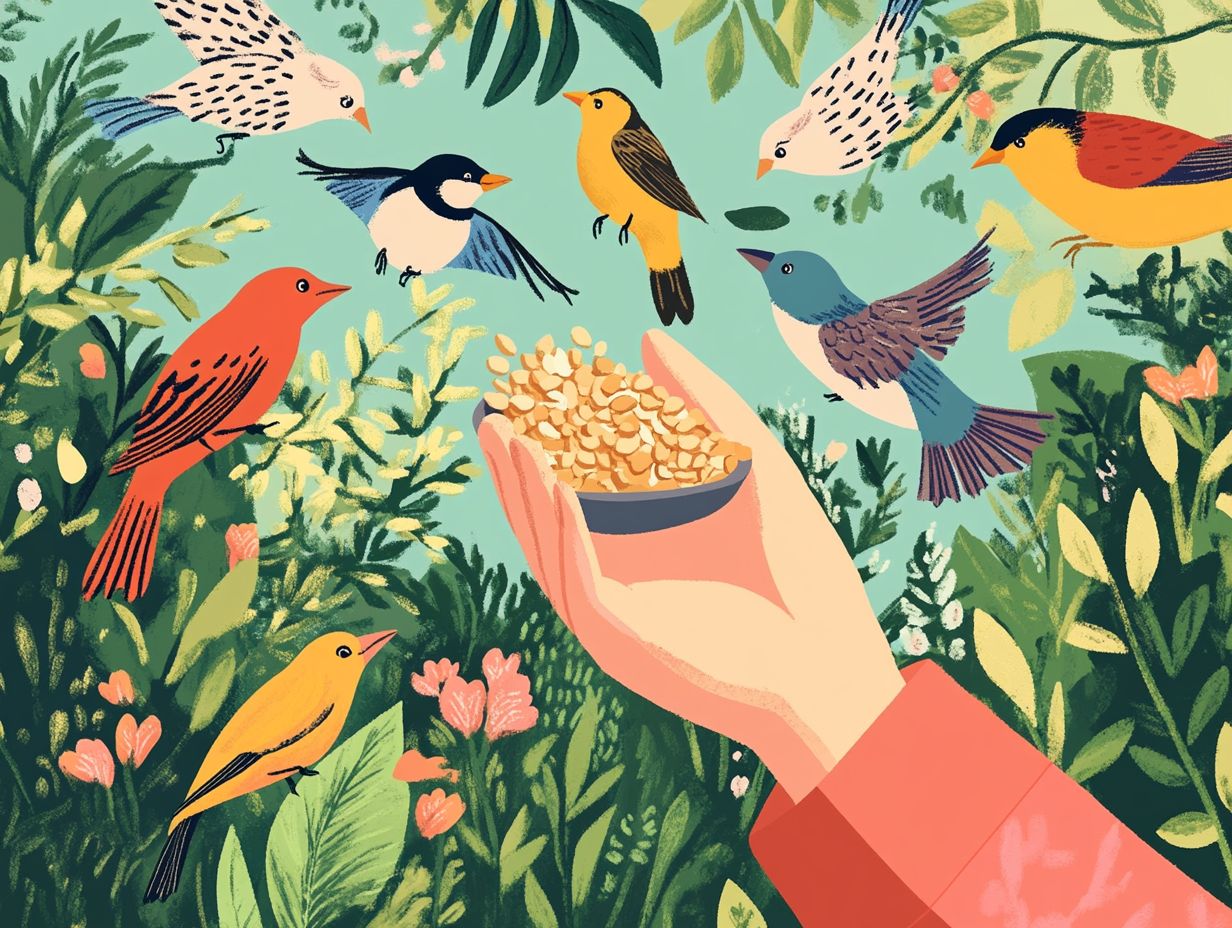
Feeding birds provides them with reliable food, especially in harsh weather. This supports their population growth and diversity.
Birds also help control insects in your yard, making it more comfortable for you.
What types of food should I offer to birds?
Seeds, suet, and nectar are great food options for birds. Different species have different preferences, so offer a variety.
Avoid bread, as it lacks essential nutrients for birds.
How often should I refill my bird feeders?
Refill your bird feeders every 1-2 days, especially in winter. Fresh food keeps birds coming back.
If you notice fewer birds, it might mean your feeders need a refill.
What is the best location for bird feeders?
Place feeders in quiet, open areas close to trees or shrubs. This gives birds a safe place to perch and observe.
Avoid locations near potential predators, like cats.
How can I keep my bird feeders clean?
Keeping your bird feeders clean is essential for happy, healthy birds! Use a mixture of mild soap and water to clean them.
Disinfect feeders at least once a month for best results.
What should I do if I encounter sick or injured birds at my feeders?
Contact your local wildlife rehabilitation center if you see sick or injured birds. They have the expertise to help.
Do not handle the birds yourself, as they may carry diseases.

